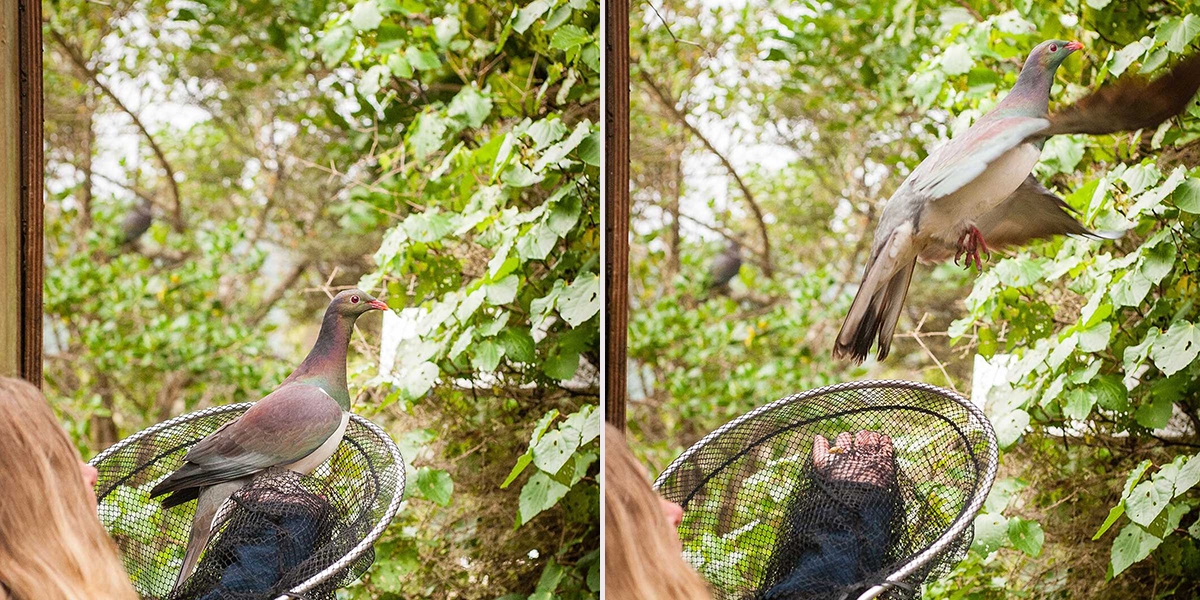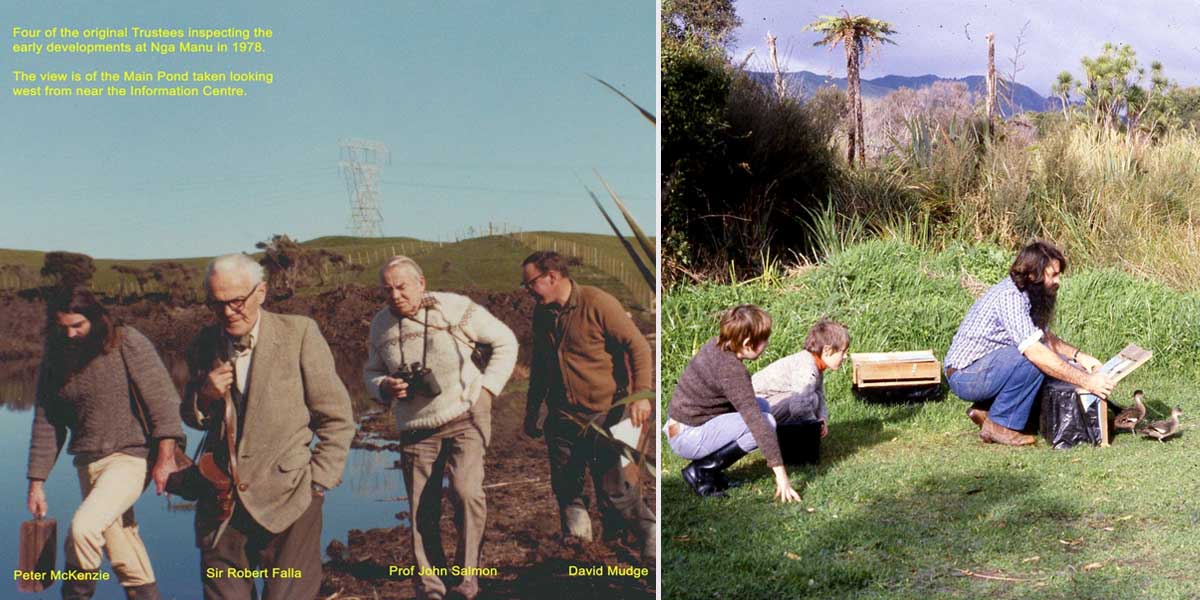About Us

Our kaupapa is rooted in the Trust’s goals to preserve and enhance native forests so that their inhabitants can flourish. Since inception Ngā Manu has partnered with DOC and others in many breed-for-release programmes which seek to re-establish at risk species of birds and reptiles into the wild. This has seen us participate in breeding programmes for kiwi, whio, pateke/brown teal, kāka, orange-fronted, red-crowned, yellow-crowned and Antipodes Island parakeet, and tuatara to name a few.
In addition to these programmes Ngā Manu has a long history of involvement in the treatment and rehabilitation of native bird species which are brought to us by the local community. Our aim is to release as many birds as possible back into the wild.
We are also deeply committed to the health of the lowland swamp forest remnant which prompted the original Trustees to take an interest in the site. One way we do this is through our volunteer-led programme of pest control. This effort is increasingly important as Ngā Manu becomes an isolated oasis in a changing landscape.
We consider the most important first step of any successful conservation to be strengthening the connection between people and the natural world. The Reserve is a regular destination for school groups of all ages. Staff and volunteers introduce and/or guide our visitors into deeper connections with the natural world through regular tours and special presentations. We utilise our functions space Robins Nest as a classroom when needed.
Over the years many researchers have based their studies at Ngā Manu. These have involved both our captive holdings and aspects of the Reserve at large. We support the research through grants offered through Victoria University and Massey Palmerston North, as well as offering Theo’s Cottage as on-site accommodation to researchers.
Peter McKenzie was 20 years old and working as a zoo keeper at Wellington Zoo in the early 1970s. A series of discussions with David Mudge and a number of colleagues evolved into the idea of creating a ‘zoo’ of indigenous, rather than exotic, species. This idea stemmed from a concern at that time that the zoo was doing little to create awareness of New Zealand’s indigenous fauna. However, it soon became clear that the group did not have access to the kind of capital required to turn such a concept into reality. However, a few weeks before his 21st birthday Peter was told that he was to receive an inheritance from his grandfather (Sir John McKenzie, founder of the McKenzie’s chain stores and one of New Zealand’s early philanthropists), the decision was quickly made to gift one-third of it for the establishment of Ngā Manu, and the dream became a possibility.

Left Image: Founders of the Ngā Manu Trust
Right Image: Peter McKenzie and his sons release grey teal to Ngā Manu
Peter gathered together a group of exceptional people with the necessary skills and experience to serve as Trustees on the Board. They were David Mudge, with expertise in aviculture, and who had been pivotal to much of the discussion about the idea; Sir Roy McKenzie (Peter’s father), who brought business experience and knowledge of setting up charitable trusts; Sir Robert Falla, ornithologist, conservationist and museum director; and Professor John Salmon, author of numerous books on NZ flora. The Trust, established in 1974, was named Ngā Manu, Māori for ‘the birds’, with its primary objective being “to establish reserves and sanctuaries for the maintenance and preservation of New Zealand wildlife and native bush and plants, and in particular to advance knowledge of the living and breeding habits of indigenous fauna”.
FINDING AND ESTABLISHING NGĀ MANU
In late 1977, the Trustees heard of a block of land for sale in Waikanae that sounded like it had all the characteristics that the Peter and the other trustees sought: a water body (stream, lake, pond or swamp); some remnant native vegetation; an environment that had the potential for improvement through management and development; and accessibility to visitors. On their visit to the site for sale, the group climbed to the top of a small hill to survey the surroundings. There, laid out in front of them, was a small valley encompassing a wetland surrounded with bush. Peter remarked to John Salmon that if they could not get the block that was for sale, this block would be a perfect site for the reserve.
Soon after, the trustees made an initial approach to Moss Smith regarding the land that they had seen at the back of his farm. Although he was not particularly receptive to their idea, he did not dismiss them out of hand. The greatest difficulty he had was understanding just what they were proposing to do, and coming to terms with the fact that anyone could see any value in the ‘swamp’ at the back of the farm. However, with time, he not only seemed to come to accept the trustees’ proposal to establish a reserve, but he also agreed to lease the site to the Trust, for a nominal fee, for 13 years and 11 months – the maximum period that was possible under the law. Though not as ideal as an outright purchase of the land, this was nevertheless acceptable to the trustees, because they figured that if they were still there in 14 years, they would be fairly hard to shift! In March 1978 the Board approved the proposed lease, and in April the Ngā Manu Trust took over the site.
Excavation of the major ponds started in April 1978 and continued for about three months. By early June, the major excavations were finished and the boundary fence almost complete. At the first inspection of the Waikanae site, the Trustees looked down over the newly excavated ponds that Peter was proudly showing them. There was a long silence, and then the first comment from John Salmon, who exclaimed: “What a bloody mess!” Peter recalled feeling absolutely shattered. He had felt extremely positive about the progress of the ponds, but at the same time, he was able to visualise the final product of the work.
GROWTH OF THE PROJECT
Slowly Peter McKenzie’s vision took shape. The Trust developed the Reserve, creating wetlands, planting many indigenous trees and shrubs, building aviaries and animal enclosures to house numerous native birds and lizards, including the ancient tuatara. The project was joined by eminent botanist John Dawson and geologist and naturalist Charles Fleming (later to become Sir Charles Fleming). The Arboretum was planted and battles commenced against an army of introduced pests, including starlings, rabbits, rats and possums. Scaup and grey teal were introduced and in 1981 an Information Centre was built.
Ngā Manu Sanctuary was opened in late 1981 by the Minister for the Environment, Dr Ian Shearer, and was attended by local politicians, representatives from the New Zealand Wildlife Service and conservation organisations, along with many of those who had contributed to the establishment of the sanctuary. Not long afterwards, Ngā Manu was purchased from Moss Smith. By 1984 there were over 17,000 visitors per year, and in 1989 the Nocturnal House was built. The 1990s saw a significant increase in the number of visitors to the Reserve and a new Education Centre was built, which also provided a function venue for weddings and celebrations.
In 2012 Ngā Manu Trust sadly lost its founder Peter McKenzie, but his legacy lives on in the plants and animals of the Reserve. Ngā Manu Nature Reserve not only encompasses a valuable and rare fragment of original lowland forest, it also symbolises a future where our indigenous natural heritage is not only valued and preserved, but is integrated back into our landscape, lives and consciousness.
This short history was edited from the Ngā Manu History Project blog, written by Dr Catherine Knight, who was previously a Ngā Manu Trustee (Dec 2010 to July 2017).

The objectives of the Trust are the preservation and conservation of New Zealand native flora and fauna, and strengthening the connection between people and nature through education.
The Ngā Manu Trust was formed in 1974 when an opportunity arose to purchase a 14-hectare site being the largest coastal lowland swamp forest remaining on the Kāpiti Coast, perfect for delivering the objectives of the Trust. This is now known as the Ngā Manu Nature Reserve. Education and research are a major part of the Trust activities along with involvement in native species recovery programmes.
The Board comprises of the following Trustees:
Patricia Stuart (Chair)
Carol Allan
Chris Milne
David Mudge
Regan Savage
Kevin Stokes
Clare Stringer
Grant Sullivan
Ruth McKenzie (Advisory Trustee)
Morag Taimalietane (Advisory Trustee)
Click here to view the Ngā Manu 2023 Annual Performance Report
Click here to view the Nga Manu Deed of Trust
Bestowing Life Membership recognises an exceptional contribution by an individual to Ngā Manu and nominations for 2024 Life Memberships are now being sought. The Board awarded eight Life Memberships at the 2023 AGM and as part of the first round of nominations reviewed the policy and made some changes. The revised policy can be found at the link below. The main change is that serving Trustees and Staff are not eligible to receive Life Memberships.
The process for making a nomination is again simple, and may be done by a group or by one person. Please provide the following information:
Nominations must be in writing and provide the following information:
- The full name of the person being nominated.
- The names of the proposer and seconder of the nomination. If a group, the names of group members.
- A description of the service provided by the nominee to Ngā Manu.
- Why the nominee’s service is considered an “outstanding contribution” to achieving the Trust’s purpose and vision.
- Any additional information that will assist the Board’s decision-making process.
Nominations close with the General Manager on 7 February 2024 and the Board will consider all nominations received at its meeting in March. Awarding of Life Memberships will take place at the 2024 AGM on 31 July 2024.

Ngā Manu Images is a vast collection of nature images captured by Ngā Manu founders Peter McKenzie and David Mudge. Both men pioneered new techniques such as time-lapse photography. They trained their observations on drama such as nest predation, the pollination of Dactylanthus by bats, and extraordinary closeups of birds feeding. Many of the events had never been captured before and added to our understanding of complex biological relationships. Many of the images stand on the merits of their beauty alone. Both men took the view that the images should be freely available for non-commercial purposes, and especially for school students. The images featured on our website are only a small portion of what is available upon request.
We recently won the category award at the Wellington Airport Regional Community Awards
– Kāpiti and were a runner up at the Wellington Regional final for the collaboration between Ngā
Manu, Waikanae Rotary Club and Paraparaumu College. We were nominated for our work together
to deliver education programs to show students a career path in conservation and science, and to
inspire the next generation of conservation leaders to take action for nature.
Here is a short video about the work Ngā Manu has been doing: https://vimeo.com/754943588/0a8553043a







